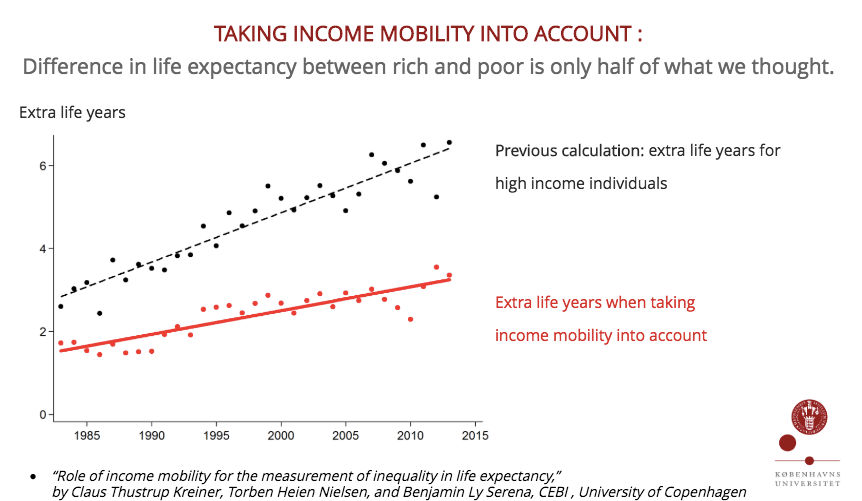IRL rich people don´t live that much longer than the poor
New research results, published by CEBI researchers in Proceedings of the National Academy of Sciences (PNAS), challenge previous findings of huge differences in life expectancy between high and low-income individuals. In real life people don´t necessarily stay poor or stay rich, as assumed in previous research. Claus Thustrup Kreiner, Torben Heien Nielsen and Benjamin Ly Serena develop new a method to take this mobility between income-classes into account providing a more realistic way to calculate life expectancy for people from different walks of society. Their results show that in reality the difference between the lifespan of a rich and a poor person is really not that big.
In 2016 impressive work published in Journal of the American Medical Association (JAMA) by a Harvard research team showed that high-income people (income percentile 80) in the US can expect to live 6.5 years longer at age 40 than low-income individuals (income percentile 20). This research gave rise to a substantial debate about inequality in health in the US.
The existing method assumes that the poor stay poor and the rich stay rich for the rest of their lives. In reality, however, over a ten-year period half of the poorest people actually move into groups with better incomes and likewise, half of the rich leak down into lower income classes. The mortality of those who move to a different income class is significantly different from those who stay in the same class.
This mobility between income classes has until now been a challenge for the measurement of inequality in life expectancy. Claus Thustrup Kreiner, Torben Heien Nielsen, and Benjamin Ly Serena from CEBI devise a new method to account for this income mobility in the relationship between income and life expectancy by incorporating a classic model from the social mobility literature.
The authors demonstrate their approach by calculating life expectancy at age 40 in Denmark based on official income and mortality records of the entire population of Danish women and men spanning the period 1983-2013.
Without accounting for income mobility, life expectancy for a 40-year-old man in the upper income groups is 78.8 years in 2013 compared with 74.2 for a man in poorer groups – a difference of 4.6 years. For women the difference between high and low-income groups is 4.1 years. However, when taking income mobility into account the life expectancy difference is half as big – around 2 years – for both men and women. Using the method, the authors suggest that inequality in life expectancy in the US is also three years rather than 6.5 years.
The difference is growing
Even though inequality in life expectancy now proves to be only half as big as earlier anticipated, the new research also shows, that the difference in life expectancy between the rich and the poor has steadily increased over the 30 years represented in the data. This is despite Denmark being a country that is internationally renowned for its free health care and education as well as a finely masked welfare-system that in many respects is thought to make up for differences in income.

Article #18-11455 in PNAS: “Role of income mobility for the measurement of inequality in life expectancy,” by Claus Thustrup Kreiner, Torben Heien Nielsen, and Benjamin Ly Serena.
CONTACT:
Claus Thustrup Kreiner, CEBI, University of Copenhagen, DENMARK; tel: +45 30 70 50 25
e-mail: ctk@econ.ku.dk
Torben Heien Nielsen, CEBI, University of Copenhagen, DENMARK; tel: +45 51 92 70 64
e-mail: thn@econ.ku.dk
Benjamin Ly Serena, CEBI, University of Copenhagen, DENMARK; tel: +45 26 99 90 20
e-mail: benjamin.ly.serena@econ.ku.dk
Janni Brixen, University of Copenhagen, Press Officer, DENMARK; tel: +45 93 56 52 57
e-mail: jab@samf.ku.dk
